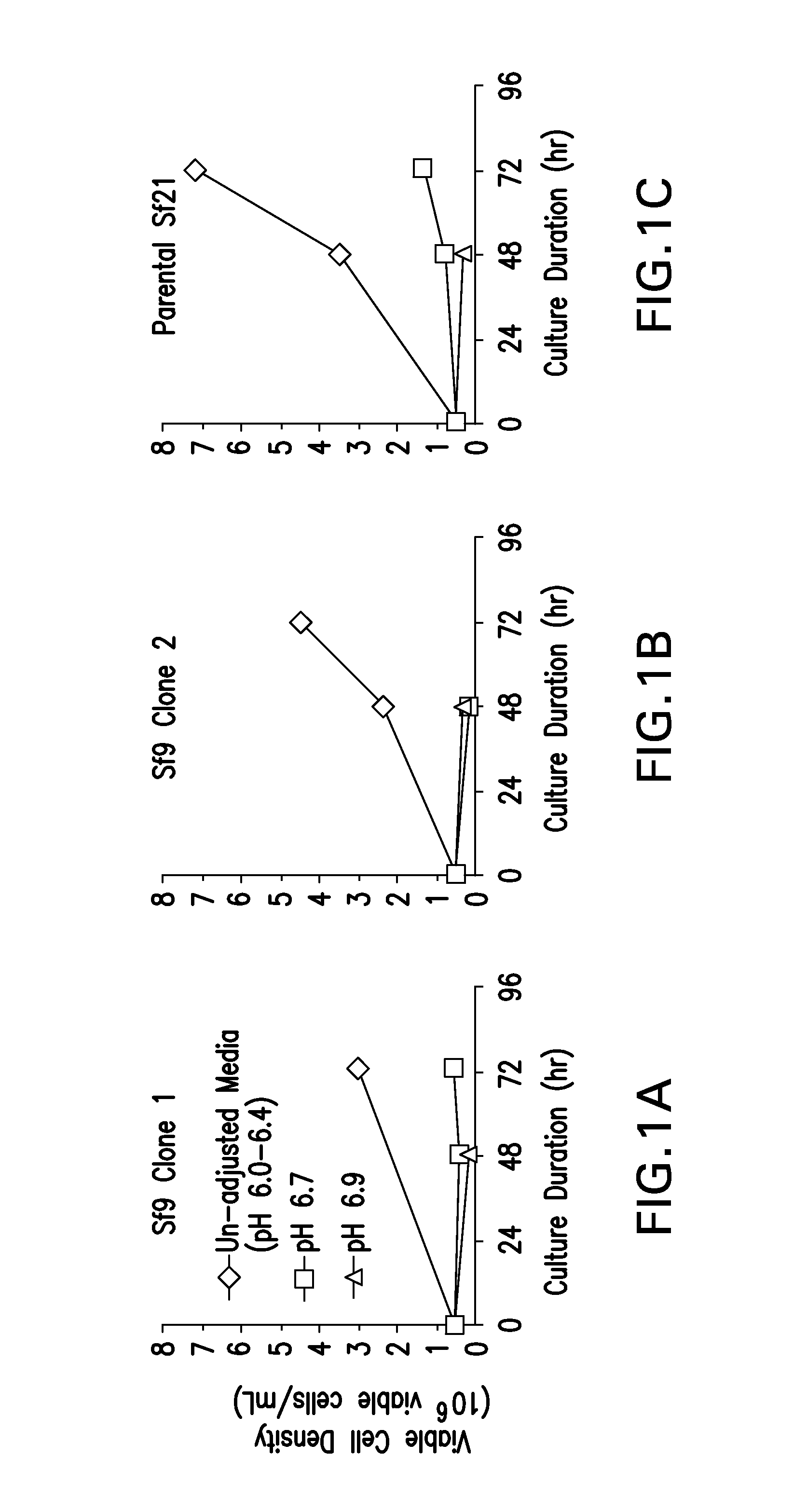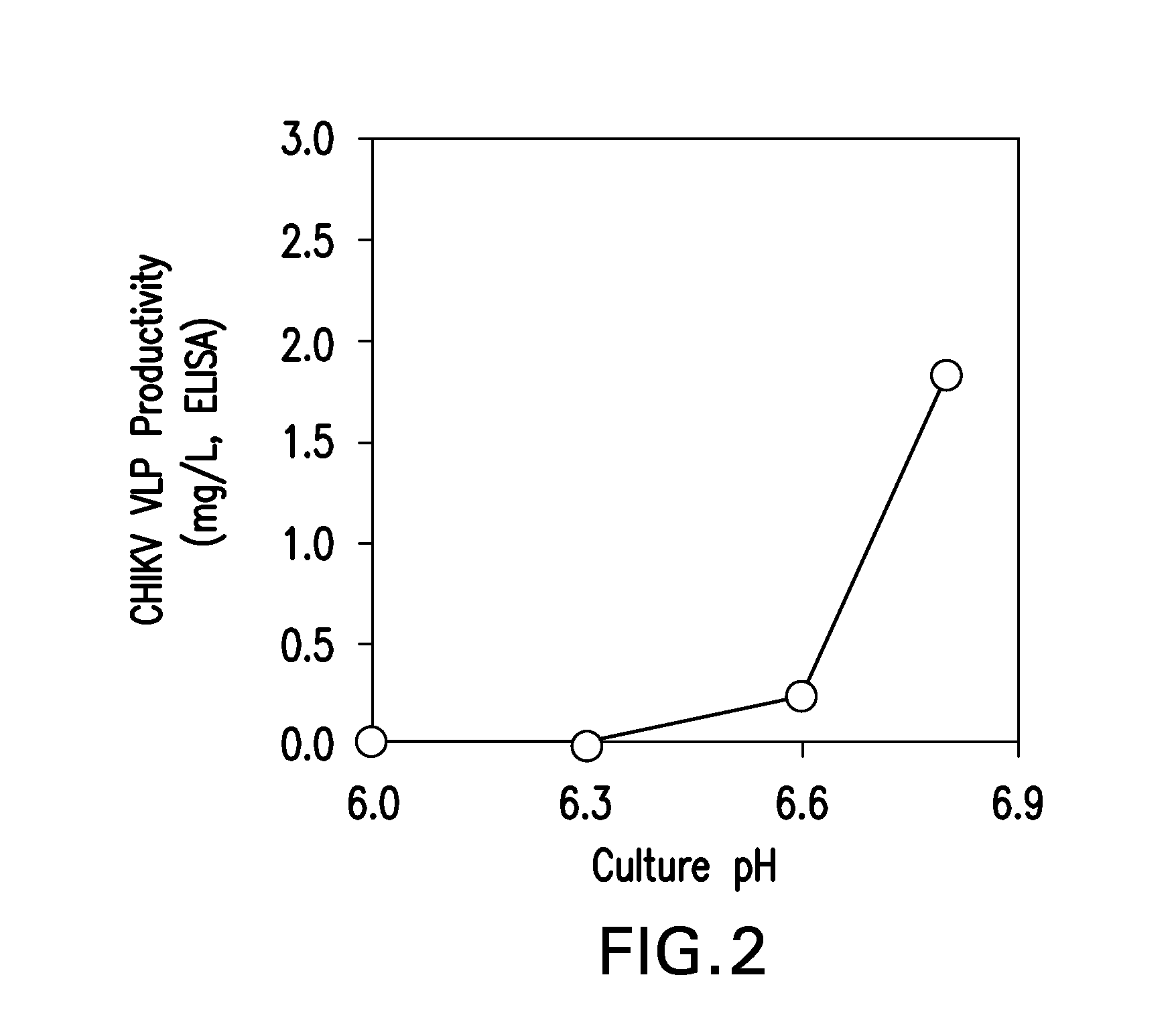Adapted lepidopteran insect cells for the production of recombinant proteins
a technology of insect cells and recombinant proteins, which is applied in the direction of peptide sources, invertebrate cells, viruses/bacteriophages, etc., can solve the problem that the target protein cannot be produced in the desired form under these conditions effectively
- Summary
- Abstract
- Description
- Claims
- Application Information
AI Technical Summary
Benefits of technology
Problems solved by technology
Method used
Image
Examples
example 1
Materials and Methods
[0094]Insect Cell Lines and Recombinant Baculovirus Stocks
[0095]Recombinant baculovirus stocks for the studies described herein were produced using standard molecular biology procedures well known in the art of baculovirus and insect cell expression; e.g. Bac-to-Bac site-specific transposition in E. coli or homologous recombination and plaque purification in insect cells. Lepidopteran insect cell lines (e.g. Sf9, Sf21, or T. ni) were maintained in continuous culture according to procedures well known in the art of insect cell culture. See Murhammer, D. W. (Ed.) 2007, Baculovirus and Insect Cell Expression Protocols, 2nd Edition. and Vlak, J. M. (Ed.) 1996, Insect Cell Cultures: Fundamental and Applied Aspects. Specifically, Spodoptera frugiperda cell lines Sf21 (Kempbio) and Sf9 (Invitrogen) were cultivated in suspension in serum-free Sf-900II (Gibco) growth media. Cells were maintained and expanded in vented Erlenmeyer shake flasks (Corning) at 27° C. in a shak...
example 2
Expression of CHIKV Polyprotein in Insect Cell Lines Using Standard Insect Cell / Baculovirus Expression Process.
[0138]Sf9, Sf21, and T ni cells (supplied by Invitrogen; Life Technologies Corp., Carlsbad, Calif.) were grown in suspension culture in commercially available growth medium (Sf-900™ III serum free medium (SFM) and Express Five® SFM (Life Technologies Corp), pH approximately 6.0-6.4) per manufacturer's recommendations and protocols well known in the art of insect cell culture (see Example 1). These cell cultures were infected with a recombinant baculovirus carrying cDNA coding for the CHIKV structural polyprotein (Capsid-E3-E2-6K-E1, UniProtKB / Swiss-Prot accession AAU43881.1) under control of the AcMNPV polyhedrin promoter to generate AcMNPV-CHIKV37997. Cell density at infection ranged from 1-2 million viable cells / mL with a multiplicity of infection (MOI) of approximately 0.1 pfu / cell. Samples were removed from the baculovirus-infected cell cultures 4 days post-infection an...
example 3
Parental Cell Line Selection
[0144]Several insect cell line variants (two Sf9 clones, and Sf21) were subjected to high pH stress to determine their resistance to high pH conditions. Sf-900™ (II or III) SFM was pH adjusted upward to various elevated pH levels by addition of NaOH to sterile growth medium. Each insect cell line variant was sub-cultured directly into the same series of pH-adjusted media formulations, and cell count and cell viability were monitored using Beckman Vi-CELL XR cell counter and image analysis software. Although Sf9 is more commonly used and is reported to be more tolerant to osmotic, pH, and shear stresses, we found that growth media pH values of 6.7 or higher did not support growth of two Sf9 variant cell lines (see FIG. 1). While adaptation of Sf9 may be possible, the parental Sf21 cell line was selected based on its survival and growth rate compared to the two tested Sf9 clones at the elevated pH levels tested.
PUM
| Property | Measurement | Unit |
|---|---|---|
| diameter | aaaaa | aaaaa |
| pH | aaaaa | aaaaa |
| pH | aaaaa | aaaaa |
Abstract
Description
Claims
Application Information
 Login to View More
Login to View More - R&D
- Intellectual Property
- Life Sciences
- Materials
- Tech Scout
- Unparalleled Data Quality
- Higher Quality Content
- 60% Fewer Hallucinations
Browse by: Latest US Patents, China's latest patents, Technical Efficacy Thesaurus, Application Domain, Technology Topic, Popular Technical Reports.
© 2025 PatSnap. All rights reserved.Legal|Privacy policy|Modern Slavery Act Transparency Statement|Sitemap|About US| Contact US: help@patsnap.com



